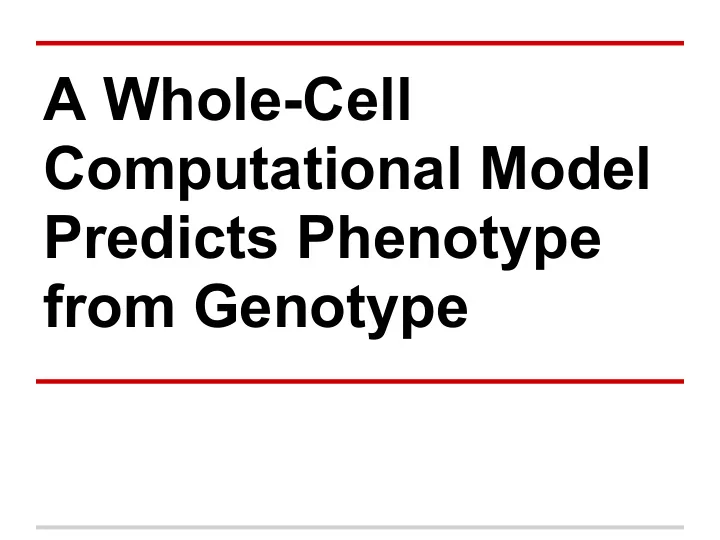

A Whole-Cell Computational Model Predicts Phenotype from Genotype
Computational Models in Biology ● Mathematically model cellular pathways to predict phenotypes ● Quantify known pieces of data to analyze the implementation of information in a cell ● More cost and time effective when compared to phenotypic assays
Mycoplasma genitalium ● Small parasitic bacterium ○ Mycoplasma ○ Evolved through genome reduction ○ Lack cell wall ● Smallest genome known ○ 580 kb ○ Self-replicating
Mycoplasma genitalium ● Discovered during drug therapy studies in 1970s ○ Investigating acute nongonococcal urethritis (NGU) ● Replicates through binary fission ● Adheres to glass and plastic surfaces ○ In the body: epithelial lining, respiratory pathways, spermatozoa, and erythrocytes
Pathogenesis ● Toxin: MG-186 ○ Degrades host nucleic acids to use for its own growth ● Localizes in immune cells ○ Prevents complete killing of bacteria ○ Low level infection persists ● Human urogential tract is preferred site for colonization
Disease ● Considered an STI and can be passed through unprotected sex ● Acute nongonococcal urethritis (NGU) ○ Inflammation of the urethra (males) ● Symptoms ○ Burning during urination ○ Discharge ○ Infertility ■ Adhere to spermatozoa ● Difficult to diagnose ○ Usually a secondary infection
Treatment ● 1 week time course of antibiotics is recommended by the CDC ○ Azithromycin ○ Doxycycline ○ Erythromycin ● A vaccine has not been developed to prevent M. genitalium infection
Diagram of the whole-cell model of Mycoplasma genitalium Whole-cell Common metabolites ● DNA ● RNA ● Protein ● and “Other” ● 28 independent submodels fit within these five categories of variables
28 independent sub-models 16 cell variables The authors started out with the assumption that each submodel within the cell ● was approximately independent from every other submodel on timescales of <1s. Simulations of the cell processes were performed as running through a loop, ● where each submodel was running independently from each other but was dependent on values from other submodels from the previous time step.
A and B. Comparison of experimental (A) and predicted ● (B) doubling times. Model validation against experimental data C. Comparison of predicted percent dry mass of the cell, ● broken into four components, with experimental data. Blue is predicted mass, Black is experimental data from Morowitz et al. (1962).
G. Simulated data from one cell showing the correlation between mRNA synthesis ( HMW2 mRNA) and “bursts” of protein synthesis Model validation against experimental data H. The lack of correlation between mRNA and protein counts in 128 individual cells is congruent with previous single-cell experiments by Taniquchi et al (2010).
So, the authors’ modeling again seems to be validated by experimental data.
Now they can do more interesting simulations: For E and F, they simulated 128 individual cells throughout the cell cycle for the binding and collision frequencies of DNA-binding proteins. E. Predicted frequency of binding and displacement of DNA-binding proteins. F. The correlation of protein density and collisions over time.
More simulations on DNA-proteins interactions B. Within 20 minutes from the start of the cell cycle, 90% of the chromosome has been traversed by one protein or another (most likely RNA-pol). C. On average, 90% of the genes have been expressed within the first 2.5 hours.
Transcription and translation dominated energy usage (by percentage of ATP and GTP used). Clearly synchronous processes
Additionally, the authors carried out simulations for quantitative ● characterization gene disruption – its effect on growth and other parameters...
Δ Δ
● ● ●
•Model is represented as a directed graph. •At each node there is conservation of flow: ∑ Inflows=∑ Outflows •Vary the flows to: - Optimize Growth - Subject to constraints
● ●
● ● ●
● ● ● ●
Recommend
More recommend